parking sensors TOYOTA SIENNA HYBRID 2021 (in English) User Guide
[x] Cancel search | Manufacturer: TOYOTA, Model Year: 2021, Model line: SIENNA HYBRID, Model: TOYOTA SIENNA HYBRID 2021Pages: 601, PDF Size: 32.07 MB
Page 325 of 601
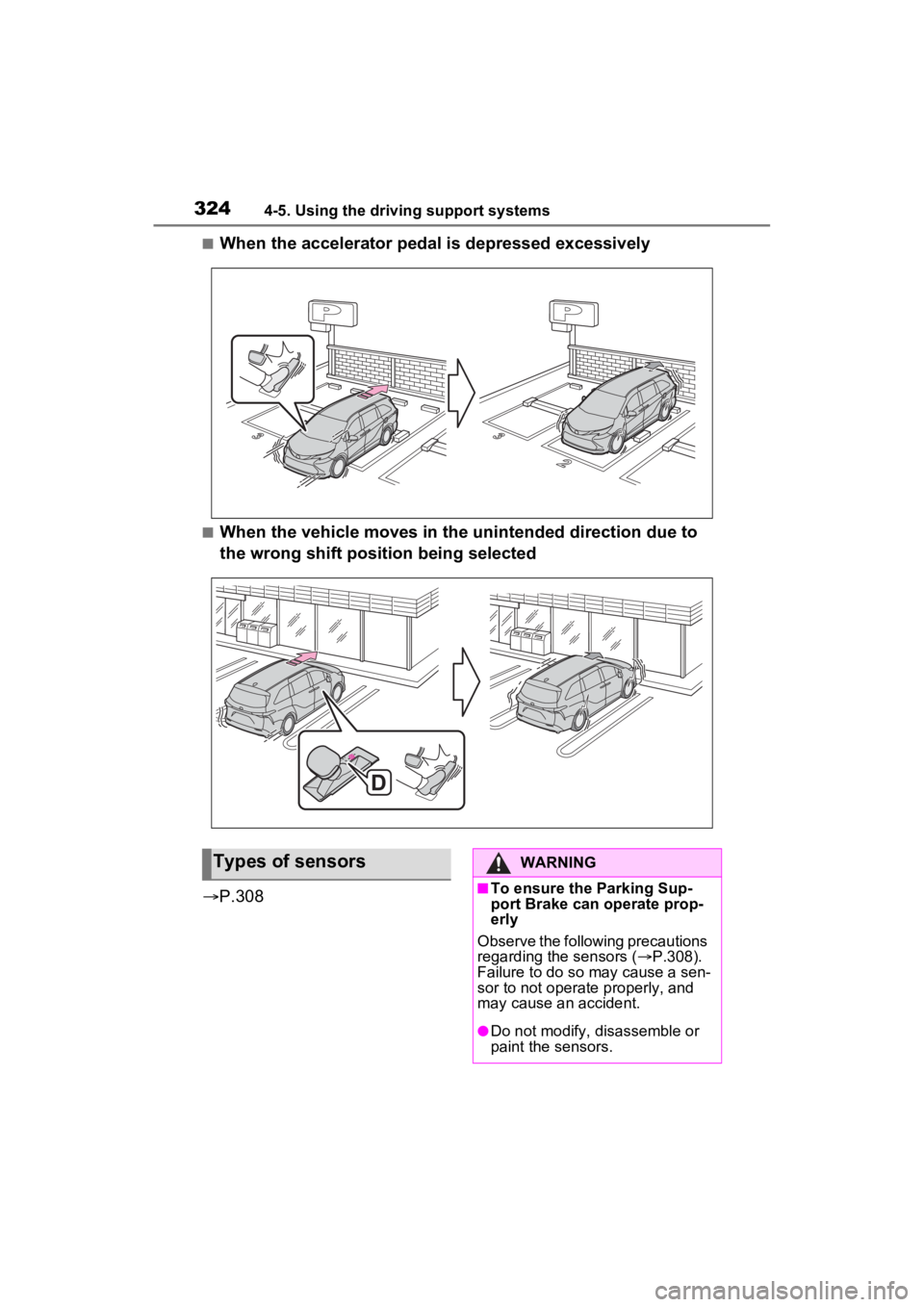
3244-5. Using the driving support systems
â– When the accelerator pedal is depressed excessively
â– When the vehicle moves in the unintended direction due to
the wrong shift position being selected
ď‚® P.308
Types of sensorsWARNING
â– To ensure the Parking Sup-
port Brake can operate prop-
erly
Observe the following precautions
regarding the sensors ( ď‚®P.308).
Failure to do so may cause a sen-
sor to not operate properly, and
may cause an accident.
â—ŹDo not modify, disassemble or
paint the sensors.
Page 326 of 601
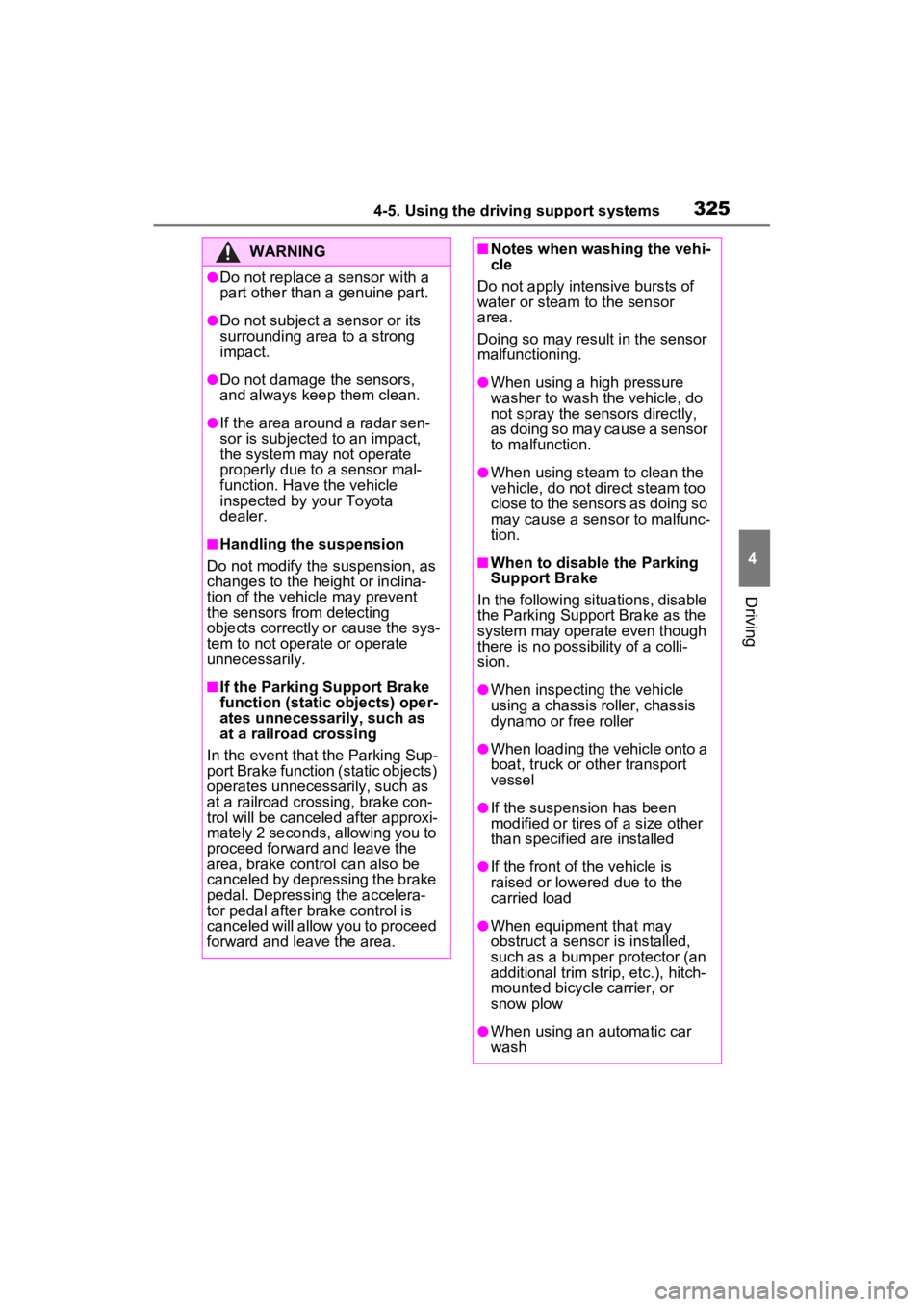
3254-5. Using the driving support systems
4
Driving
WARNING
â—ŹDo not replace a sensor with a
part other than a genuine part.
â—ŹDo not subject a sensor or its
surrounding area to a strong
impact.
â—ŹDo not damage the sensors,
and always keep them clean.
â—ŹIf the area around a radar sen-
sor is subjected to an impact,
the system may not operate
properly due to a sensor mal-
function. Have the vehicle
inspected by your Toyota
dealer.
â– Handling the suspension
Do not modify the suspension, as
changes to the height or inclina-
tion of the vehicle may prevent
the sensors from detecting
objects correctly or cause the sys-
tem to not operate or operate
unnecessarily.
â– If the Parking Support Brake
function (static objects) oper-
ates unnecessarily, such as
at a railroad crossing
In the event that the Parking Sup-
port Brake function (static objects)
operates unnecessarily, such as
at a railroad cross ing, brake con-
trol will be cancele d after approxi-
mately 2 seconds, allowing you to
proceed forward and leave the
area, brake control can also be
canceled by depressing the brake
pedal. Depressing the accelera-
tor pedal after brake control is
canceled will allow you to proceed
forward and leave the area.
â– Notes when washing the vehi-
cle
Do not apply intensive bursts of
water or steam to the sensor
area.
Doing so may result in the sensor
malfunctioning.
â—ŹWhen using a high pressure
washer to wash the vehicle, do
not spray the sensors directly,
as doing so may cause a sensor
to malfunction.
â—ŹWhen using steam to clean the
vehicle, do not direct steam too
close to the sensors as doing so
may cause a sensor to malfunc-
tion.
â– When to disable the Parking
Support Brake
In the following situations, disable
the Parking Suppor t Brake as the
system may opera te even though
there is no possibility of a colli-
sion.
â—ŹWhen inspecting the vehicle
using a chassis roller, chassis
dynamo or free roller
â—ŹWhen loading the vehicle onto a
boat, truck or other transport
vessel
â—ŹIf the suspension has been
modified or tires of a size other
than specified are installed
â—ŹIf the front of the vehicle is
raised or lowered due to the
carried load
â—ŹWhen equipment that may
obstruct a sensor is installed,
such as a bumper protector (an
additional trim strip, etc.), hitch-
mounted bicycle carrier, or
snow plow
â—ŹWhen using an automatic car
wash
Page 327 of 601
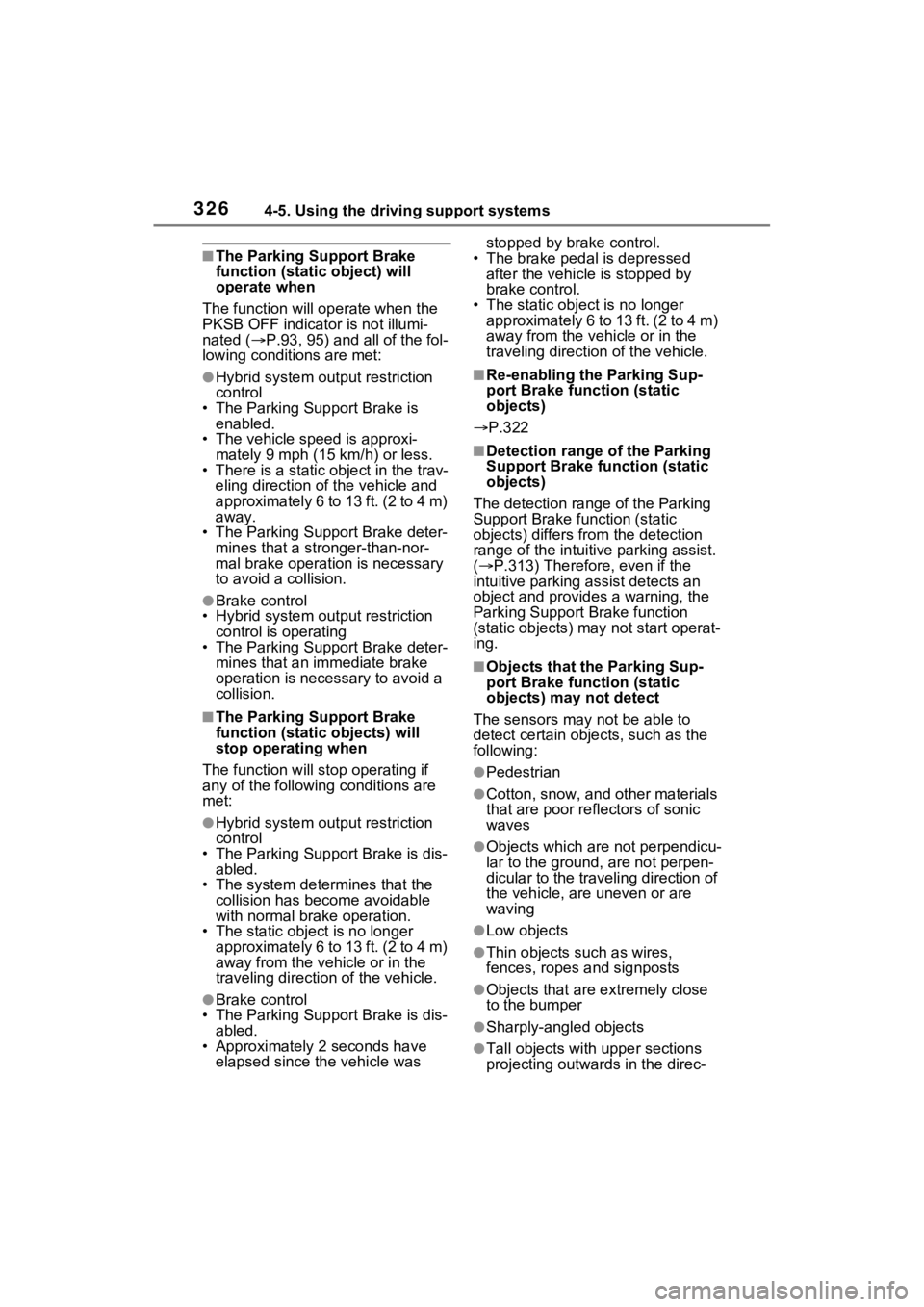
3264-5. Using the driving support systems
â– The Parking Support Brake
function (static object) will
operate when
The function will op erate when the
PKSB OFF indicato r is not illumi-
nated ( ď‚®P.93, 95) and all of the fol-
lowing conditions are met:
â—ŹHybrid system output restriction
control
• The Parking Support Brake is enabled.
• The vehicle speed is approxi-
mately 9 mph (15 km/h) or less.
• There is a static object in the trav- eling direction o f the vehicle and
approximately 6 to 13 ft. (2 to 4 m)
away.
• The Parking Support Brake deter-
mines that a stronger-than-nor-
mal brake operation is necessary
to avoid a collision.
â—ŹBrake control
• Hybrid system output restriction
control is operating
• The Parking Support Brake deter- mines that an immediate brake
operation is necessary to avoid a
collision.
â– The Parking Support Brake
function (static objects) will
stop operating when
The function will st op operating if
any of the following conditions are
met:
â—ŹHybrid system output restriction
control
• The Parking Support Brake is dis- abled.
• The system determines that the collision has beco me avoidable
with normal brake operation.
• The static object is no longer approximately 6 to 13 ft. (2 to 4 m)
away from the vehicle or in the
traveling directi on of the vehicle.
â—ŹBrake control
• The Parking Support Brake is dis- abled.
• Approximately 2 seconds have
elapsed since the vehicle was stopped by brake control.
• The brake pedal is depressed after the vehicle is stopped by
brake control.
• The static object is no longer approximately 6 to 13 ft. (2 to 4 m)
away from the vehicle or in the
traveling direction of the vehicle.
â– Re-enabling the Parking Sup-
port Brake function (static
objects)
ď‚® P.322
â– Detection range of the Parking
Support Brake function (static
objects)
The detection range of the Parking
Support Brake function (static
objects) differs from the detection
range of the intuiti ve parking assist.
( ď‚® P.313) Therefore, even if the
intuitive parking assist detects an
object and provides a warning, the
Parking Support Brake function
(static objects) may not start operat-
ing.
â– Objects that the Parking Sup-
port Brake function (static
objects) may not detect
The sensors may not be able to
detect certain objects, such as the
following:
â—ŹPedestrian
â—ŹCotton, snow, and other materials
that are poor re flectors of sonic
waves
â—ŹObjects which are not perpendicu-
lar to the ground, are not perpen-
dicular to the traveling direction of
the vehicle, are uneven or are
waving
â—ŹLow objects
â—ŹThin objects such as wires,
fences, ropes and signposts
â—ŹObjects that are e xtremely close
to the bumper
â—ŹSharply-angled objects
â—ŹTall objects with upper sections
projecting outwards in the direc-
Page 328 of 601
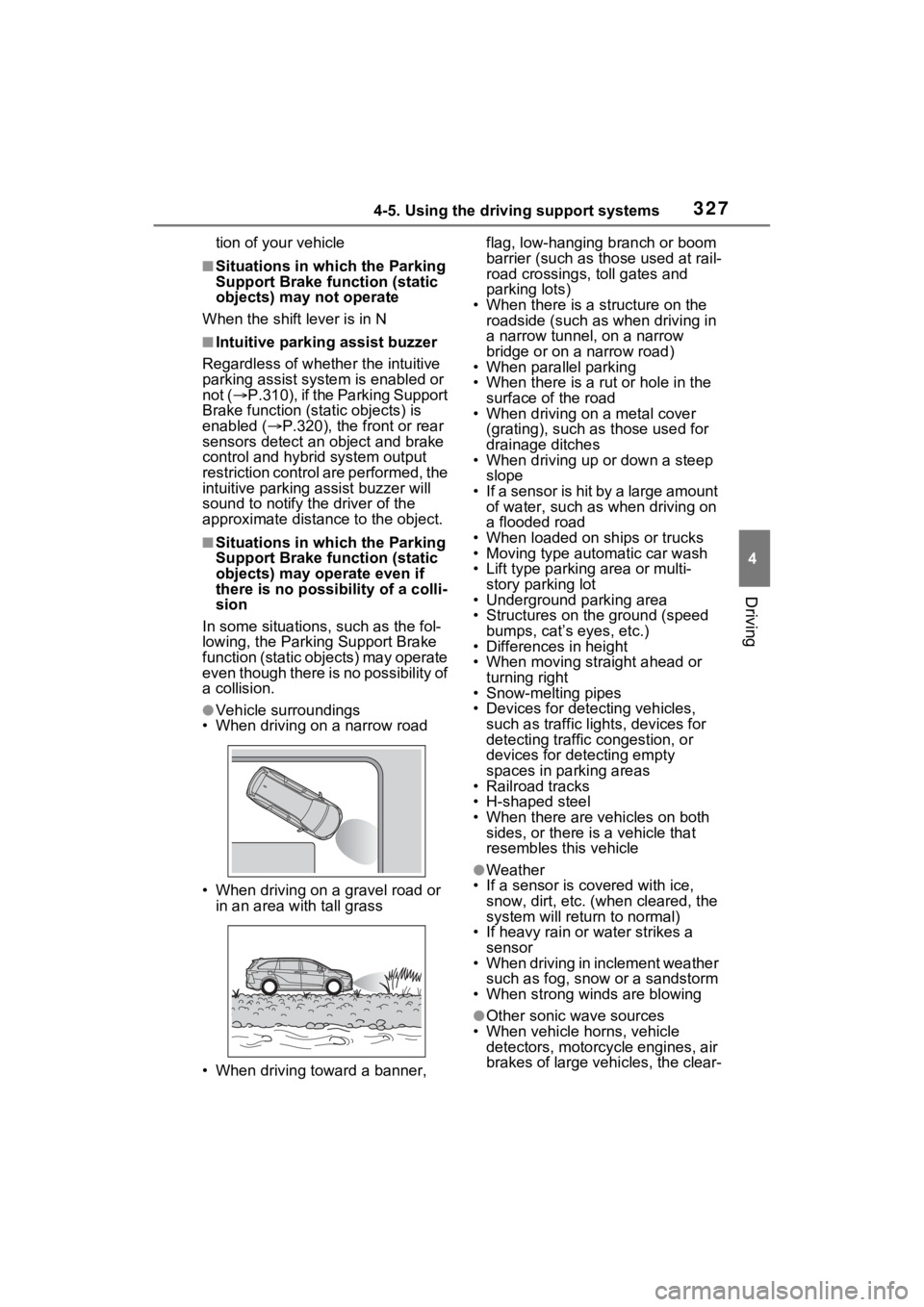
3274-5. Using the driving support systems
4
Driving
tion of your vehicle
â– Situations in which the Parking
Support Brake function (static
objects) may not operate
When the shift lever is in N
â– Intuitive parking assist buzzer
Regardless of whether the intuitive
parking assist syste m is enabled or
not ( ď‚®P.310), if the Parking Support
Brake function (static objects) is
enabled ( ď‚®P.320), the front or rear
sensors detect an object and brake
control and hybrid system output
restriction control are performed, the
intuitive parking assist buzzer will
sound to notify the driver of the
approximate distanc e to the object.
â– Situations in which the Parking
Support Brake function (static
objects) may operate even if
there is no possibility of a colli-
sion
In some situations, such as the fol-
lowing, the Parking Support Brake
function (static objects) may operate
even though there is no possibility of
a collision.
â—ŹVehicle surroundings
• When driving on a narrow road
• When driving on a gravel road or in an area with tall grass
• When driving toward a banner, flag, low-hanging branch or boom
barrier (such as those used at rail-
road crossings, toll gates and
parking lots)
• When there is a structure on the roadside (such as when driving in
a narrow tunnel , on a narrow
bridge or on a narrow road)
• When parallel parking
• When there is a rut or hole in the
surface of the road
• When driving on a metal cover
(grating), such as those used for
drainage ditches
• When driving up or down a steep
slope
• If a sensor is hit by a large amount of water, such as when driving on
a flooded road
• When loaded on ships or trucks
• Moving type automatic car wash
• Lift type parking area or multi- story parking lot
• Underground parking area
• Structures on the ground (speed
bumps, cat’s eyes, etc.)
• Differences in height
• When moving straight ahead or
turning right
• Snow-melting pipes
• Devices for detecting vehicles,
such as traffic lig hts, devices for
detecting traffic congestion, or
devices for detecting empty
spaces in parking areas
• Railroad tracks
• H-shaped steel
• When there are vehicles on both sides, or there is a vehicle that
resembles this vehicle
â—ŹWeather
• If a sensor is covered with ice, snow, dirt, etc. (when cleared, the
system will return to normal)
• If heavy rain or water strikes a sensor
• When driving in inclement weather such as fog, snow or a sandstorm
• When strong winds are blowing
â—ŹOther sonic wave sources
• When vehicle horns, vehicle detectors, motorcycle engines, air
brakes of large vehicles, the clear-
Page 330 of 601
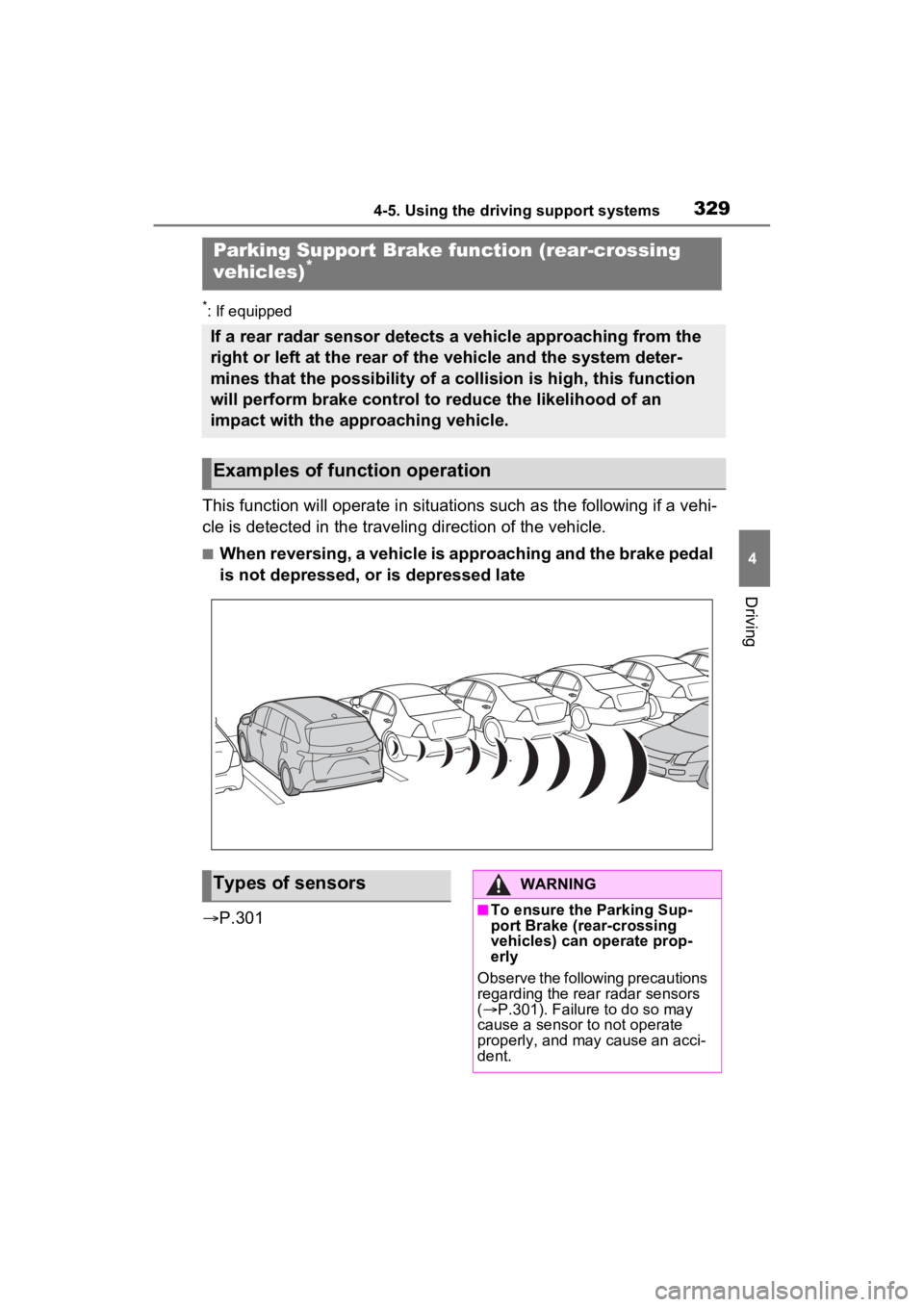
3294-5. Using the driving support systems
4
Driving
*: If equipped
This function will operate in situations such as the following if a vehi-
cle is detected in the traveling direction of the vehicle.
â– When reversing, a vehicle is approaching and the brake pedal
is not depressed, or is depressed late
ď‚® P.301
Parking Support Brake function (rear-crossing
vehicles)*
If a rear radar sensor detects a vehicle approaching from the
right or left at the rear of the vehicle and the system deter-
mines that the possibility of a collision is high, this function
will perform brake control to reduce the likelihood of an
impact with the approaching vehicle.
Examples of function operation
Types of sensorsWARNING
â– To ensure the Parking Sup-
port Brake (rear-crossing
vehicles) can operate prop-
erly
Observe the following precautions
regarding the rear radar sensors
( ď‚® P.301). Failure to do so may
cause a sensor t o not operate
properly, and may cause an acci-
dent.
Page 331 of 601
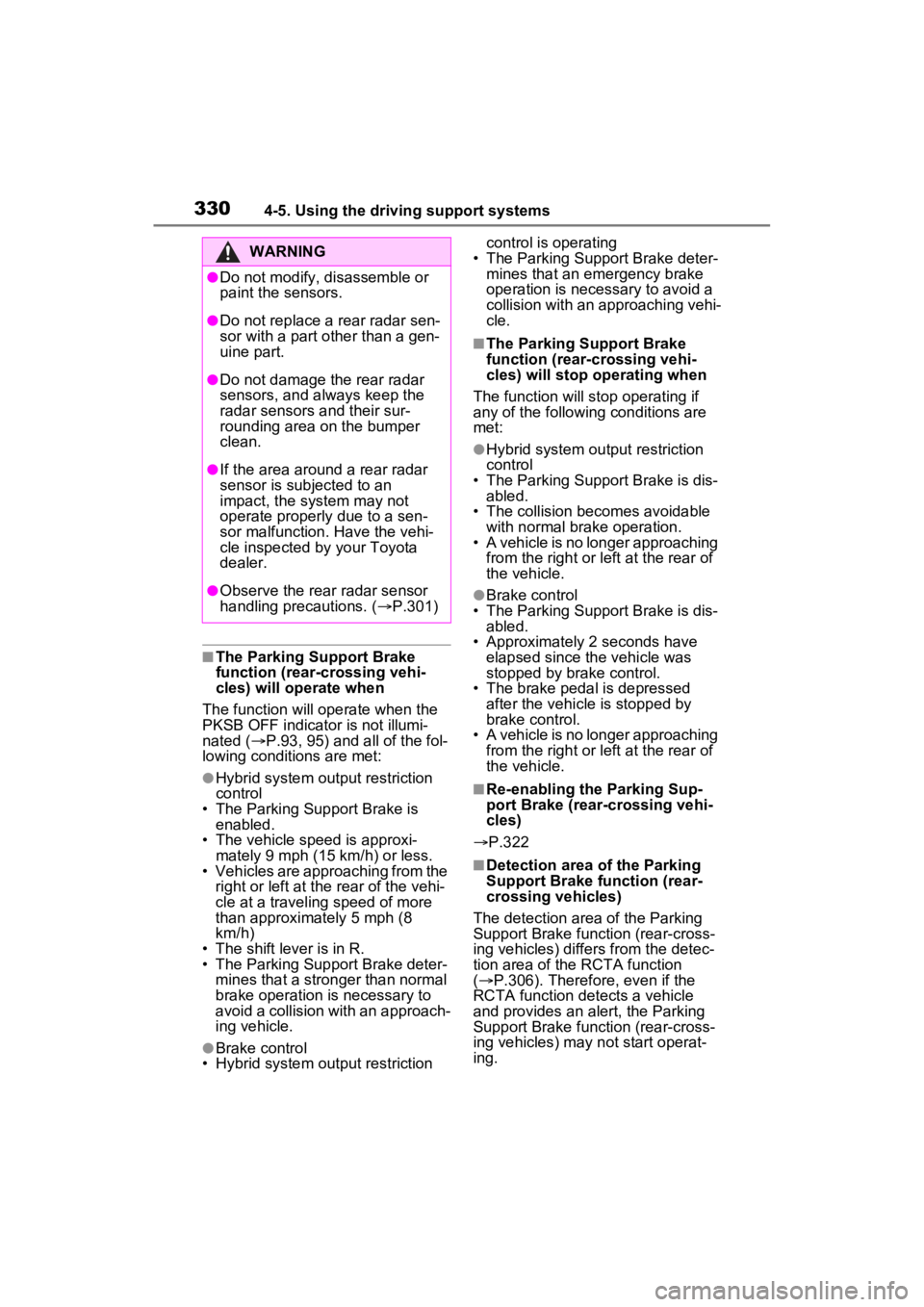
3304-5. Using the driving support systems
â– The Parking Support Brake
function (rear-crossing vehi-
cles) will operate when
The function will operate when the
PKSB OFF indicator is not illumi-
nated ( ď‚®P.93, 95) and all of the fol-
lowing conditions are met:
â—ŹHybrid system output restriction
control
• The Parking Support Brake is enabled.
• The vehicle speed is approxi-
mately 9 mph (15 km/h) or less.
• Vehicles are approaching from the right or left at th e rear of the vehi-
cle at a traveling speed of more
than approximately 5 mph (8
km/h)
• The shift lever is in R.
• The Parking Support Brake deter- mines that a stronger than normal
brake operation is necessary to
avoid a collision with an approach-
ing vehicle.
â—ŹBrake control
• Hybrid system output restriction control is operating
• The Parking Support Brake deter- mines that an emergency brake
operation is necessary to avoid a
collision with an approaching vehi-
cle.
â– The Parking Support Brake
function (rear-crossing vehi-
cles) will stop operating when
The function will stop operating if
any of the following conditions are
met:
â—ŹHybrid system output restriction
control
• The Parking Support Brake is dis- abled.
• The collision becomes avoidable
with normal brake operation.
• A vehicle is no longer approaching from the right or left at the rear of
the vehicle.
â—ŹBrake control
• The Parking Support Brake is dis- abled.
• Approximately 2 seconds have
elapsed since the vehicle was
stopped by brake control.
• The brake pedal is depressed
after the vehicle is stopped by
brake control.
• A vehicle is no longer approaching
from the right or left at the rear of
the vehicle.
â– Re-enabling the Parking Sup-
port Brake (rear-crossing vehi-
cles)
ď‚® P.322
â– Detection area of the Parking
Support Brake function (rear-
crossing vehicles)
The detection area of the Parking
Support Brake function (rear-cross-
ing vehicles) differs from the detec-
tion area of the RCTA function
( ď‚® P.306). Therefore, even if the
RCTA function detects a vehicle
and provides an alert, the Parking
Support Brake function (rear-cross-
ing vehicles) may not start operat-
ing.
WARNING
â—ŹDo not modify, disassemble or
paint the sensors.
â—ŹDo not replace a rear radar sen-
sor with a part o ther than a gen-
uine part.
â—ŹDo not damage the rear radar
sensors, and always keep the
radar sensors and their sur-
rounding area on the bumper
clean.
â—ŹIf the area around a rear radar
sensor is subjected to an
impact, the system may not
operate properly due to a sen-
sor malfunction. Have the vehi-
cle inspected by your Toyota
dealer.
â—ŹObserve the rear radar sensor
handling precautions. ( ď‚®P.301)
Page 332 of 601
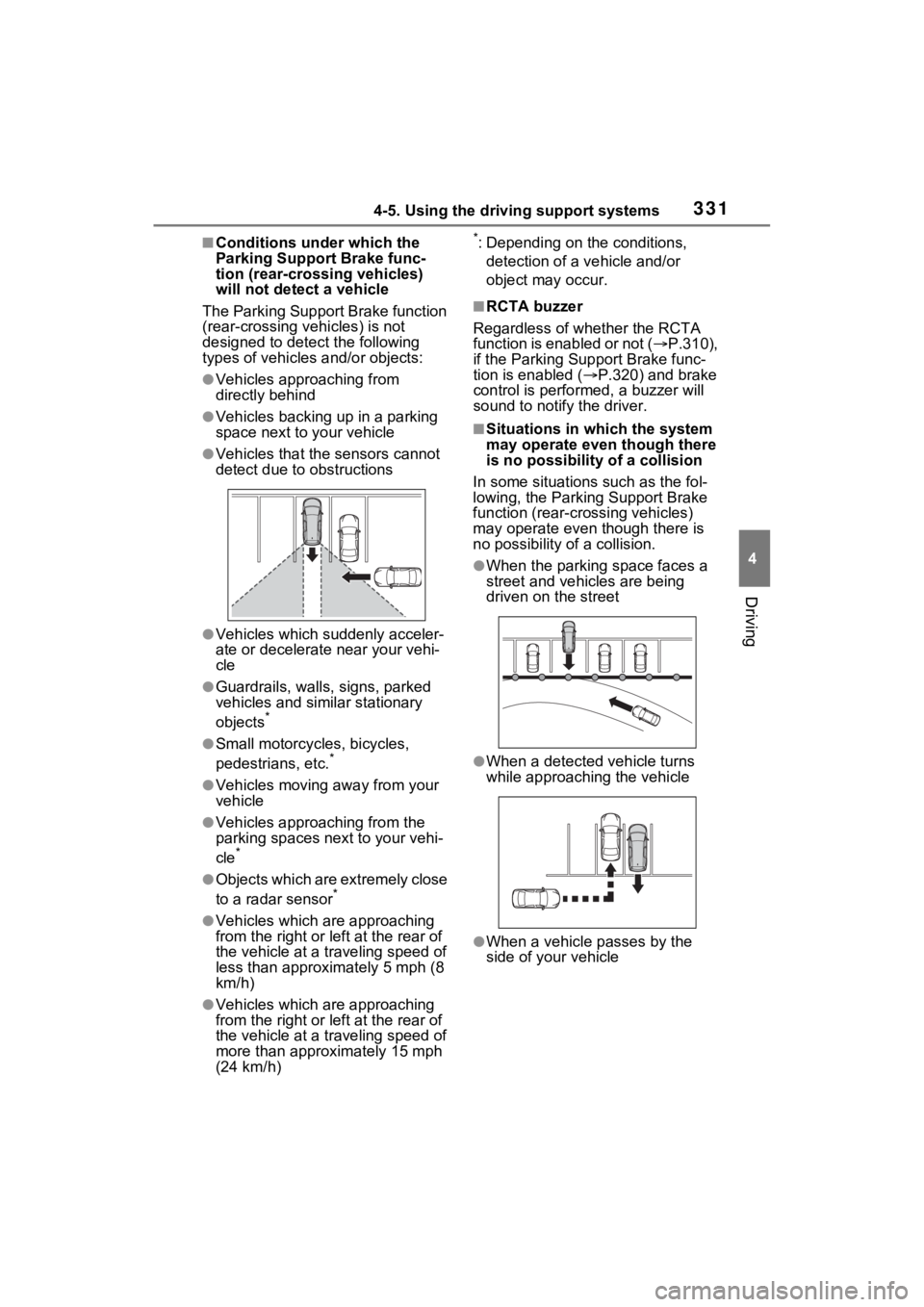
3314-5. Using the driving support systems
4
Driving
â– Conditions under which the
Parking Support Brake func-
tion (rear-crossing vehicles)
will not detect a vehicle
The Parking Support Brake function
(rear-crossing vehicles) is not
designed to detect the following
types of vehicles and/or objects:
â—ŹVehicles approaching from
directly behind
â—ŹVehicles backing up in a parking
space next to your vehicle
â—ŹVehicles that the sensors cannot
detect due to obstructions
â—ŹVehicles which suddenly acceler-
ate or decelerate near your vehi-
cle
â—ŹGuardrails, walls, signs, parked
vehicles and similar stationary
objects
*
â—ŹSmall motorcycles, bicycles,
pedestrians, etc.*
â—ŹVehicles moving away from your
vehicle
â—ŹVehicles approaching from the
parking spaces next to your vehi-
cle
*
â—ŹObjects which are extremely close
to a radar sensor*
â—ŹVehicles which are approaching
from the right or left at the rear of
the vehicle at a traveling speed of
less than approxi mately 5 mph (8
km/h)
â—ŹVehicles which are approaching
from the right or left at the rear of
the vehicle at a traveling speed of
more than approximately 15 mph
(24 km/h)
*: Depending on the conditions,
detection of a v ehicle and/or
object may occur.
â– RCTA buzzer
Regardless of whether the RCTA
function is enabled or not ( ď‚®P.310),
if the Parking Support Brake func-
tion is enabled ( ď‚®P.320) and brake
control is perfo rmed, a buzzer will
sound to notify the driver.
â– Situations in which the system
may operate even though there
is no possibility of a collision
In some situations such as the fol-
lowing, the Parking Support Brake
function (rear-cro ssing vehicles)
may operate even t hough there is
no possibility of a collision.
â—ŹWhen the parking space faces a
street and vehicles are being
driven on the street
â—ŹWhen a detected vehicle turns
while approaching the vehicle
â—ŹWhen a vehicle passes by the
side of your vehicle
Page 333 of 601
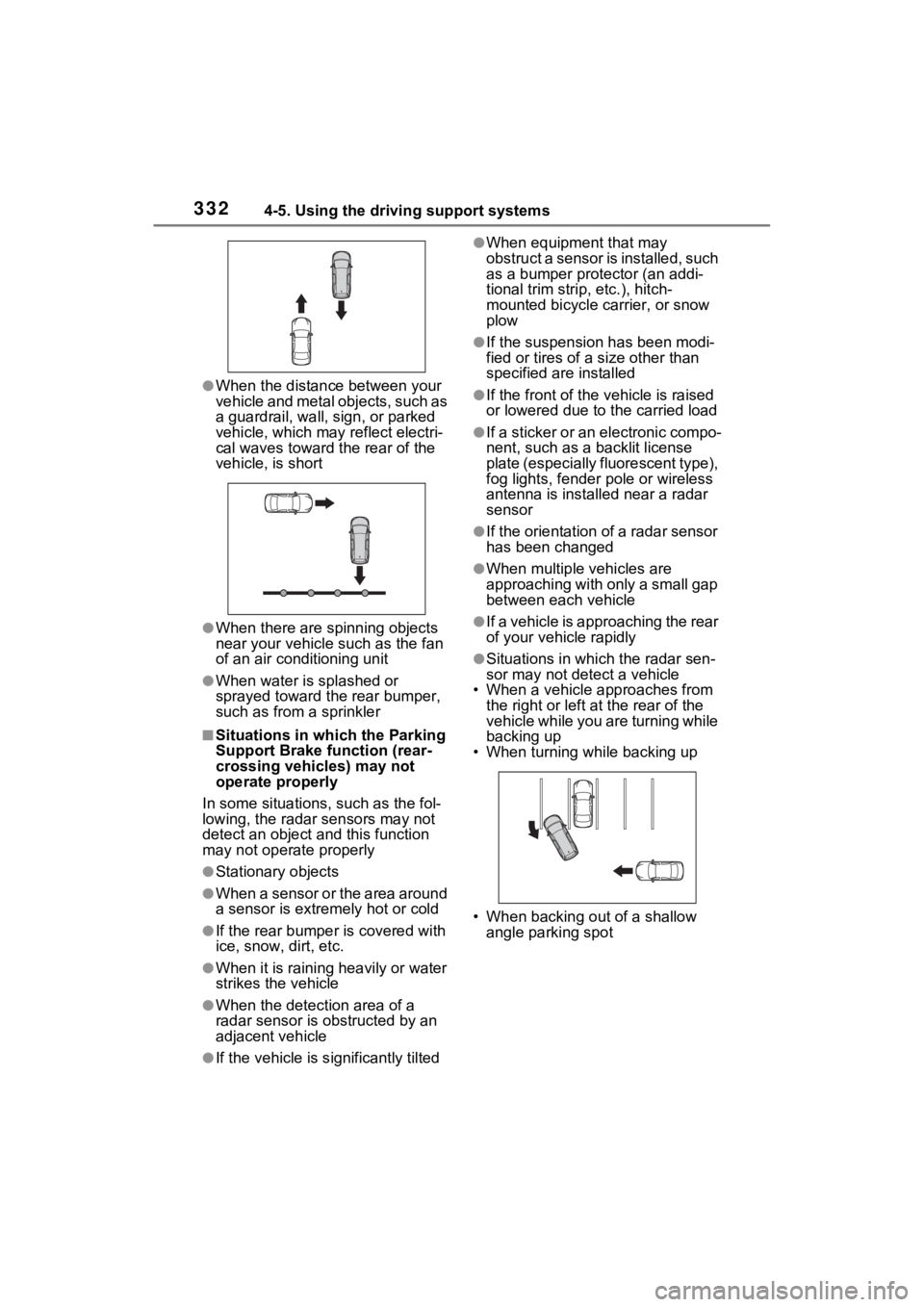
3324-5. Using the driving support systems
â—ŹWhen the distance between your
vehicle and metal objects, such as
a guardrail, wall, sign, or parked
vehicle, which may reflect electri-
cal waves toward the rear of the
vehicle, is short
â—ŹWhen there are spinning objects
near your vehicle such as the fan
of an air conditioning unit
â—ŹWhen water is splashed or
sprayed toward t he rear bumper,
such as from a sprinkler
â– Situations in which the Parking
Support Brake function (rear-
crossing vehicles) may not
operate properly
In some situations, such as the fol-
lowing, the radar sensors may not
detect an object and this function
may not operate properly
â—ŹStationary objects
â—ŹWhen a sensor or the area around
a sensor is extremely hot or cold
â—ŹIf the rear bumper is covered with
ice, snow, dirt, etc.
â—ŹWhen it is raining heavily or water
strikes the vehicle
â—ŹWhen the detecti on area of a
radar sensor is obstructed by an
adjacent vehicle
â—ŹIf the vehicle is s ignificantly tilted
â—ŹWhen equipment that may
obstruct a sensor is installed, such
as a bumper protector (an addi-
tional trim strip, etc.), hitch-
mounted bicycle carrier, or snow
plow
â—ŹIf the suspension has been modi-
fied or tires of a size other than
specified are installed
â—ŹIf the front of the v ehicle is raised
or lowered due to the carried load
â—ŹIf a sticker or an electronic compo-
nent, such as a backlit license
plate (especially fluorescent type),
fog lights, fender pole or wireless
antenna is installed near a radar
sensor
â—ŹIf the orientation of a radar sensor
has been changed
â—ŹWhen multiple vehicles are
approaching with only a small gap
between each vehicle
â—ŹIf a vehicle is approaching the rear
of your vehicle rapidly
â—ŹSituations in which the radar sen-
sor may not detect a vehicle
• When a vehicle approaches from
the right or left at the rear of the
vehicle while you are turning while
backing up
• When turning while backing up
• When backing out of a shallow angle parking spot
Page 580 of 601

Alphabetical Index579
P
Panic mode ............................. 130
Parking assist sensors (intuitive parking assist) ...................... 308
Parking brake Operation ............................. 243
Parking brake engaged warning buzzer ................................ 245
Warning light ........................ 472
Warning message ................ 244
Parking lights Light switch .......................... 248
Replacing light bulbs ............ 451
Parking Support Brake (PKSB) ............................................... 319Indicator ................................. 95
Parking Support Brake function (rear-crossing vehicles) ...... 329
Parking Support Brake function (static objects) .................... 323
Warning light ........................ 470
PCS (Pre-Collision System) Enabling/disabling the pre-colli-sion system ........................ 269
Function ............................... 267
Warning light ........................ 469
Warning message ........ 265, 480
Personal lights ....................... 364 Switch................................... 364
Wattage ................................ 526
PKSB (Parking Support Brake) ............................................... 319Indicator ................................. 95
Parking Support Brake function (rear-crossing vehicles) ...... 329
Parking Support Brake function (static objects) .................... 323
Warning light ........................ 470
Power back door switch ........ 154
Power outlets .................. 374, 375
Power sliding door main switch ...............................................149
Power steering (Electric Power Steering system)...................336Warning light ........................468
Power switch...........................231 Auto power off fun ction.........235
Changing the power switch modes.................................234
Starting the hybrid system ....231
Power windows Door lock linked window opera-tion......................................202
Jam protection function ........201
Operation..............................201
Window lock switch ..............203
Pre-Collision System (PCS) Enabling/disabling the pre-colli-sion system ........................269
Function................................267
Warning light ........................469
Warning messag e ........265, 480
R
Radar cruise control
Dynamic radar cruise control with full-speed range ..........288
Radiator ...................................420
RCD (Rear Came ra Detection)
Function................................315
Warning message . ...............317
RCTA (Rear Cross Traffic Alert) RCTA Function .....................305
Warning message . ...............301
Rear automatic air conditioning system ...................................358
Rear Cross Traffic Alert (RCTA) ...............................................299
Rear heater system ................358
Rear passengers’ seat belt reminder light........................473
Rear seat Head restraints .....................182